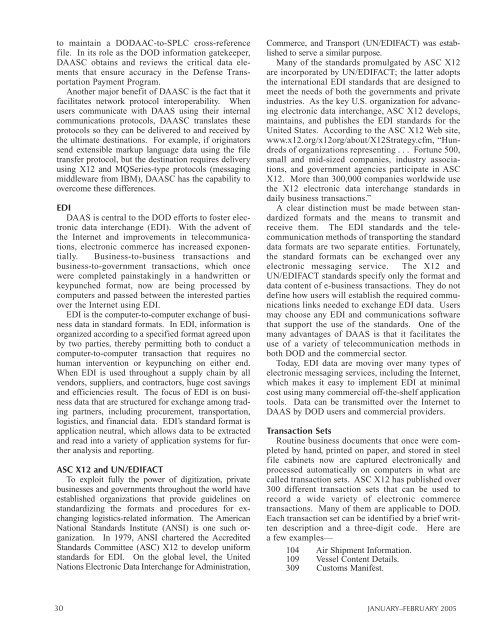Supporting the First Stryker Brigade in Iraq - Army Logistics ...
Supporting the First Stryker Brigade in Iraq - Army Logistics ...
Supporting the First Stryker Brigade in Iraq - Army Logistics ...
Create successful ePaper yourself
Turn your PDF publications into a flip-book with our unique Google optimized e-Paper software.
to ma<strong>in</strong>ta<strong>in</strong> a DODAAC-to-SPLC cross-reference<br />
file. In its role as <strong>the</strong> DOD <strong>in</strong>formation gatekeeper,<br />
DAASC obta<strong>in</strong>s and reviews <strong>the</strong> critical data elements<br />
that ensure accuracy <strong>in</strong> <strong>the</strong> Defense Transportation<br />
Payment Program.<br />
Ano<strong>the</strong>r major benefit of DAASC is <strong>the</strong> fact that it<br />
facilitates network protocol <strong>in</strong>teroperability. When<br />
users communicate with DAAS us<strong>in</strong>g <strong>the</strong>ir <strong>in</strong>ternal<br />
communications protocols, DAASC translates <strong>the</strong>se<br />
protocols so <strong>the</strong>y can be delivered to and received by<br />
<strong>the</strong> ultimate dest<strong>in</strong>ations. For example, if orig<strong>in</strong>ators<br />
send extensible markup language data us<strong>in</strong>g <strong>the</strong> file<br />
transfer protocol, but <strong>the</strong> dest<strong>in</strong>ation requires delivery<br />
us<strong>in</strong>g X12 and MQSeries-type protocols (messag<strong>in</strong>g<br />
middleware from IBM), DAASC has <strong>the</strong> capability to<br />
overcome <strong>the</strong>se differences.<br />
EDI<br />
DAAS is central to <strong>the</strong> DOD efforts to foster electronic<br />
data <strong>in</strong>terchange (EDI). With <strong>the</strong> advent of<br />
<strong>the</strong> Internet and improvements <strong>in</strong> telecommunications,<br />
electronic commerce has <strong>in</strong>creased exponentially.<br />
Bus<strong>in</strong>ess-to-bus<strong>in</strong>ess transactions and<br />
bus<strong>in</strong>ess-to-government transactions, which once<br />
were completed pa<strong>in</strong>stak<strong>in</strong>gly <strong>in</strong> a handwritten or<br />
keypunched format, now are be<strong>in</strong>g processed by<br />
computers and passed between <strong>the</strong> <strong>in</strong>terested parties<br />
over <strong>the</strong> Internet us<strong>in</strong>g EDI.<br />
EDI is <strong>the</strong> computer-to-computer exchange of bus<strong>in</strong>ess<br />
data <strong>in</strong> standard formats. In EDI, <strong>in</strong>formation is<br />
organized accord<strong>in</strong>g to a specified format agreed upon<br />
by two parties, <strong>the</strong>reby permitt<strong>in</strong>g both to conduct a<br />
computer-to-computer transaction that requires no<br />
human <strong>in</strong>tervention or keypunch<strong>in</strong>g on ei<strong>the</strong>r end.<br />
When EDI is used throughout a supply cha<strong>in</strong> by all<br />
vendors, suppliers, and contractors, huge cost sav<strong>in</strong>gs<br />
and efficiencies result. The focus of EDI is on bus<strong>in</strong>ess<br />
data that are structured for exchange among trad<strong>in</strong>g<br />
partners, <strong>in</strong>clud<strong>in</strong>g procurement, transportation,<br />
logistics, and f<strong>in</strong>ancial data. EDI’s standard format is<br />
application neutral, which allows data to be extracted<br />
and read <strong>in</strong>to a variety of application systems for fur<strong>the</strong>r<br />
analysis and report<strong>in</strong>g.<br />
ASC X12 and UN/EDIFACT<br />
To exploit fully <strong>the</strong> power of digitization, private<br />
bus<strong>in</strong>esses and governments throughout <strong>the</strong> world have<br />
established organizations that provide guidel<strong>in</strong>es on<br />
standardiz<strong>in</strong>g <strong>the</strong> formats and procedures for exchang<strong>in</strong>g<br />
logistics-related <strong>in</strong>formation. The American<br />
National Standards Institute (ANSI) is one such organization.<br />
In 1979, ANSI chartered <strong>the</strong> Accredited<br />
Standards Committee (ASC) X12 to develop uniform<br />
standards for EDI. On <strong>the</strong> global level, <strong>the</strong> United<br />
Nations Electronic Data Interchange for Adm<strong>in</strong>istration,<br />
30<br />
Commerce, and Transport (UN/EDIFACT) was established<br />
to serve a similar purpose.<br />
Many of <strong>the</strong> standards promulgated by ASC X12<br />
are <strong>in</strong>corporated by UN/EDIFACT; <strong>the</strong> latter adopts<br />
<strong>the</strong> <strong>in</strong>ternational EDI standards that are designed to<br />
meet <strong>the</strong> needs of both <strong>the</strong> governments and private<br />
<strong>in</strong>dustries. As <strong>the</strong> key U.S. organization for advanc<strong>in</strong>g<br />
electronic data <strong>in</strong>terchange, ASC X12 develops,<br />
ma<strong>in</strong>ta<strong>in</strong>s, and publishes <strong>the</strong> EDI standards for <strong>the</strong><br />
United States. Accord<strong>in</strong>g to <strong>the</strong> ASC X12 Web site,<br />
www.x12.org/x12org/about/X12Strategy.cfm, “Hundreds<br />
of organizations represent<strong>in</strong>g . . . Fortune 500,<br />
small and mid-sized companies, <strong>in</strong>dustry associations,<br />
and government agencies participate <strong>in</strong> ASC<br />
X12. More than 300,000 companies worldwide use<br />
<strong>the</strong> X12 electronic data <strong>in</strong>terchange standards <strong>in</strong><br />
daily bus<strong>in</strong>ess transactions.”<br />
A clear dist<strong>in</strong>ction must be made between standardized<br />
formats and <strong>the</strong> means to transmit and<br />
receive <strong>the</strong>m. The EDI standards and <strong>the</strong> telecommunication<br />
methods of transport<strong>in</strong>g <strong>the</strong> standard<br />
data formats are two separate entities. Fortunately,<br />
<strong>the</strong> standard formats can be exchanged over any<br />
electronic messag<strong>in</strong>g service. The X12 and<br />
UN/EDIFACT standards specify only <strong>the</strong> format and<br />
data content of e-bus<strong>in</strong>ess transactions. They do not<br />
def<strong>in</strong>e how users will establish <strong>the</strong> required communications<br />
l<strong>in</strong>ks needed to exchange EDI data. Users<br />
may choose any EDI and communications software<br />
that support <strong>the</strong> use of <strong>the</strong> standards. One of <strong>the</strong><br />
many advantages of DAAS is that it facilitates <strong>the</strong><br />
use of a variety of telecommunication methods <strong>in</strong><br />
both DOD and <strong>the</strong> commercial sector.<br />
Today, EDI data are mov<strong>in</strong>g over many types of<br />
electronic messag<strong>in</strong>g services, <strong>in</strong>clud<strong>in</strong>g <strong>the</strong> Internet,<br />
which makes it easy to implement EDI at m<strong>in</strong>imal<br />
cost us<strong>in</strong>g many commercial off-<strong>the</strong>-shelf application<br />
tools. Data can be transmitted over <strong>the</strong> Internet to<br />
DAAS by DOD users and commercial providers.<br />
Transaction Sets<br />
Rout<strong>in</strong>e bus<strong>in</strong>ess documents that once were completed<br />
by hand, pr<strong>in</strong>ted on paper, and stored <strong>in</strong> steel<br />
file cab<strong>in</strong>ets now are captured electronically and<br />
processed automatically on computers <strong>in</strong> what are<br />
called transaction sets. ASC X12 has published over<br />
300 different transaction sets that can be used to<br />
record a wide variety of electronic commerce<br />
transactions. Many of <strong>the</strong>m are applicable to DOD.<br />
Each transaction set can be identified by a brief written<br />
description and a three-digit code. Here are<br />
a few examples—<br />
104 Air Shipment Information.<br />
109 Vessel Content Details.<br />
309 Customs Manifest.<br />
JANUARY–FEBRUARY 2005







